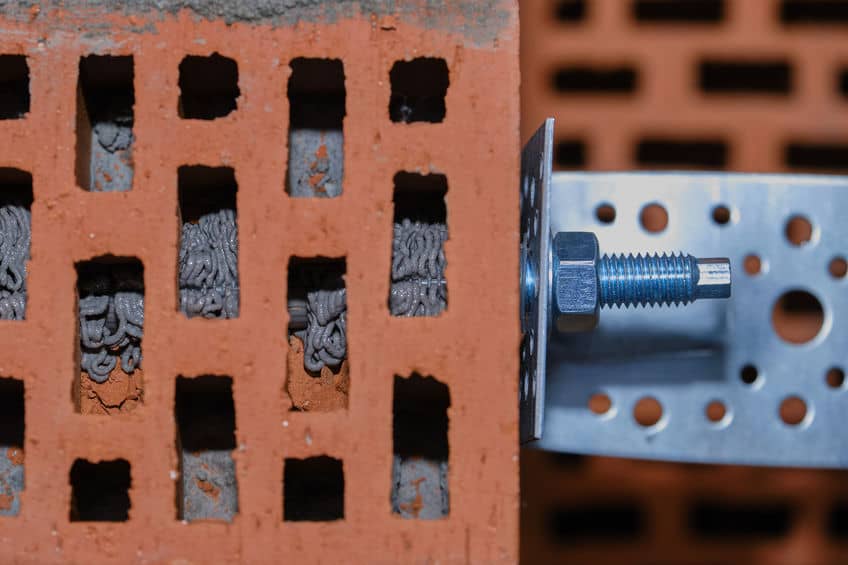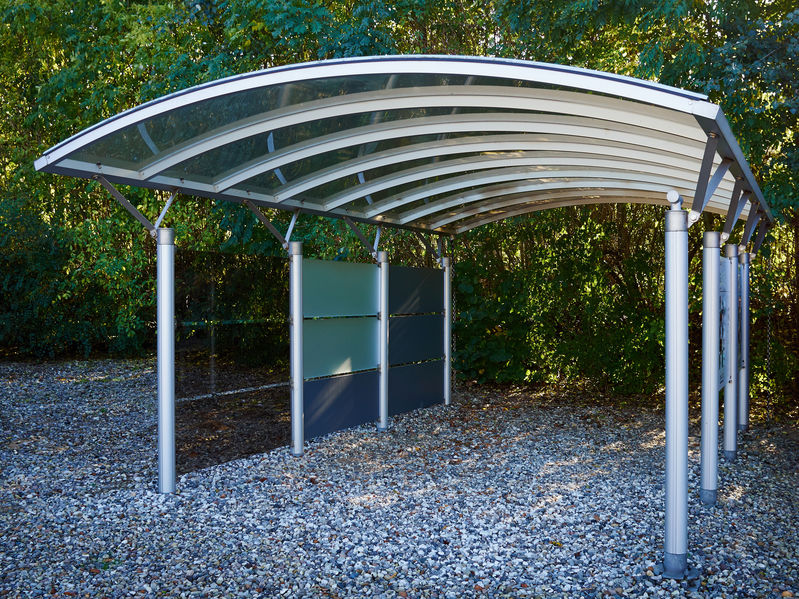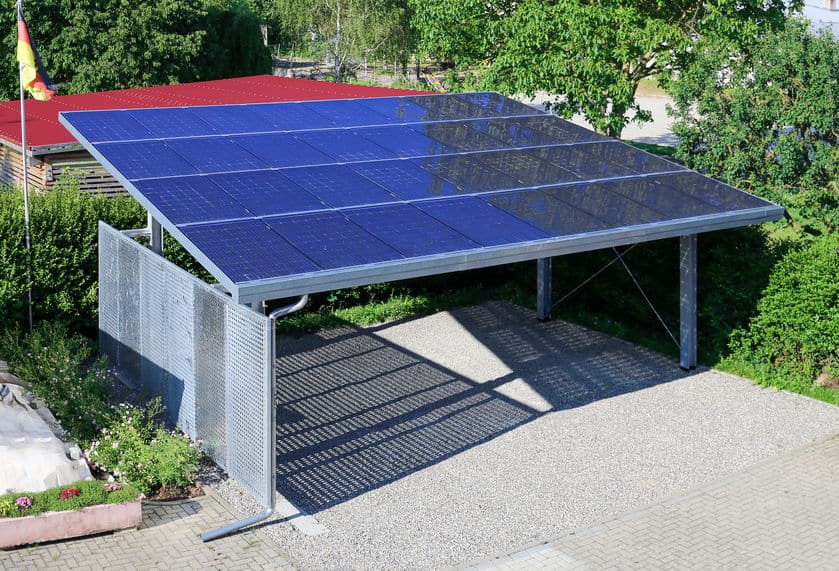Carports are an excellent way to protect your parked car from the elements. That’s why people invest in them in the first place!
But what if you live in an area with strong winds, and your carport keeps swaying? Is there a way to stop that from happening?
The answer is yes! There are several ways that you can secure your carport against strong winds and prevent swaying. And that’s what we’re going to explore in this article.
Let’s get started.
Why Do Carports Sway?
First and foremost, it’s essential to understand why carports sway in the first place.
That way, you’ll be able to understand what solutions might fit better for your carport in particular.
Typically, this happens because of a lack of siding walls, bad positioning of the carports, or even because its bolts have loosened over time.
No Sidewalls
Carports come in all shapes and sizes. At the bare minimum, a carport may consist of only four pillars and a roof, under which you’d park your car.
While a structure like this may be enough to protect your vehicle from rain, snow, and falling debris, it doesn’t stand up so well against the wind.
Sidewalls are excellent at minimising swaying because they provide stability between pillars.
As a result, carports with two or more sidewalls tend to stand up to blowing winds much better and sway a lot less.
Bad Positioning
Some carports sway more than others because they’re located out in the open.
That can be a problem, seeing as there’s nothing to buffer the windows that blow towards the structure.
Had the carport been built right next to a home, barn, or similar structure, the wind’s effects would be minimized and the carport would sway a lot less.
Loose Bolts

Believe it or not, the bolts that you find at the carport’s footings can gradually loosen over time and lead to excess swaying.
Those bolts may not seem like much, but they’re critical not only to keep the structure standing but also to prevent it from swaying from side to side whenever the wind is blowing.
How Do I Stop My Carport From Swaying?
Ideally, the best way to stop a carport from swaying is to prepare for it before the structure is even built.
In doing so, you’d have much more flexibility to choose a more aerodynamic design for the carport that reduces the effects of blowing wind.
Plus, you could also scout for a better location to place it and strengthen the overall structure’s foundation.
With that said, a standing carport can also be strengthened to reduce swaying.
Some standard practices include adding sidewalls to the structure, improving the anchoring, and adding additional bracing to support the carport’s structure.
Let’s take a closer look at each of those best practices that help to stop carports from swaying.

Best Practices To Stop Carports Swaying
Let’s be clear though: some of these steps, like Step 1 and Step 2, are much simpler to do in the planning stages before the carport is actually built.
But don’t worry! We’ve also included a few steps that are very straightforward even with a standing and fully-functional carport.
Here they are:
Step 1: Choose A Better Location
One of the most famous sayings in real estate is that it’s always about ‘location, location, location’! Well, that’s certainly true when it comes to preventing carports from swaying as well.
Sure, the whole purpose of a carport is to protect whatever’s inside from the elements, including the wind. But by choosing a better location to build the carport, you’ll make it much easier for the carport to do that job.
Typically, people place carports closer to the main building. In most cases, that means building the carport right next to the home, which is an overall much more stable building.
In doing so, the house will act as a buffer to reduce the carport’s exposure to wind.
Suppose you’d like to eliminate the carport’s swaying entirely. If that’s the case, then you could also build the carport to attach directly to the structure of your home.
That way, the carport will no longer be a free-standing structure that sways with the wind.
By being connected to the house which has a much stronger foundation and larger size, the carport’s swaying will be reduced to next to nothing.
Step 2: Build A Stronger Foundation
The integrity of any structure begins with its foundation. That’s as true for the tallest skyscrapers as it is for the simplest of carports.
When planning how you’ll build your carport’s foundation, you can prevent swaying by going deeper and/or go wider.
For instance, a carport will sway a lot less if the concrete footings go much deeper into the ground, say four or more feet.
Deeper footings, especially those made with concrete, will keep the pillars standing firm even when windows are blowing strong.
Still, if you have the resources, an ideal solution would be to use a concrete slab as the foundation of the entire carport.
Sure, that’ll involve a much higher cost and many more man hours to prepare, but there is no foundation more stable for a carport than that.
Step 3: Add Sidewalls

Carports can be very simple, consisting of nothing more than four pillars and roof. If you prefer, you could also have it be more substantial by including sidewalls.
As mentioned earlier, sidewalls do a fantastic job of reducing swaying by adding more stability between the pillars of the carport.
Just by adding one sidewall, you’ll be able to decrease any swaying experienced by the carport.
Still, it’s a much more common practice to have at least two sidewalls on opposing sides to provide carports with more well-distributed support.
It is possible to have more than two sidewalls, of course, and that will provide the structure with even more stability.
However, you may want to check with local building codes before doing that. In some places, the number of walls may affect the definition of the structure, crossing the line between it being considered a ‘carport’ or a ‘garage’.
Step 4: Use Anchoring
Quite often, you can reduce swaying without making any changes to the structure of the carport. Instead, you could just upgrade the existing anchoring that you may already have.
When it comes to anchoring, it’s important to use the correct type to match the foundation underneath the structure. For instance, you’re better off using concrete anchors if your carport has a concrete base.
That way, all of the pieces will work well together to keep your carport stable even when facing heavy winds.
Other types of carport anchors include those specially made for asphalt or soil. These anchors typically have screw-like parts that offer you two benefits: they’re much easier to screw into the ground, and they do a fantastic job of keeping your carport in place.
Simply put: the deeper those anchors go and the stronger they can grip the ground, the more stability they’ll add to your carport.
Step 5: Add Bracing
Another step that you can take to prevent swaying is to add bracing to your carport.
This is yet another modification that doesn’t require you to alter the design or foundation of the existing carport, as you’ll just be adding a few pieces to reduce movement in the structure.
Typically, carport bracing will go well near the footings or closer to the roof.
For example, whether you’re using a metal or wooden carport, you could add additional metal rods or bars around each footing.
When bolted to the existing structure, these bars will work well to keep each pillar perfectly straight and prevent them from swaying side to side.
The same is also true for bracing that’s added to the roof area. Essentially, bracing closer towards the top will prevent the roof from swaying when heavy winds start pushing against it.
Do Metal Or Wooden Carports Sway Less?
Does your choice in carport building materials make a difference? Yes, it does, both directly and indirectly!
See, metal and wood both provide carports with unique benefits. Wooden carports tend to be lighter and more affordable, but they don’t hold up that well against strong winds.
Metal carports are the opposite, weighing much more than their wooden counterparts. As a direct effect, they’re much better at staying on the ground and therefore sway a lot less.
Still, the weight of the material isn’t the only issue, as there are indirect factors at play here, too.
Typically, people who choose metal carports will also invest in a more substantial foundation; either with concrete footings that go deeper into the ground or whole concrete slabs.
These choices indirectly reduce the overall swaying of the carport.
Wooden carport buyers, however, typically do not see the need for very strong foundations.
So, their carports are left more susceptible to swaying unless they choose to implement the steps mentioned earlier to strengthen their carports.
If you’re enjoying this article then why not check out these related articles:
43 Stunning ABOVE GROUND pool ideas that you need to SEE!
17 Hot Tub Enclosure Ideas That Will Blow Your Mind
How Close to the Boundary Can I Build a Carport? (Easy Checklist)

